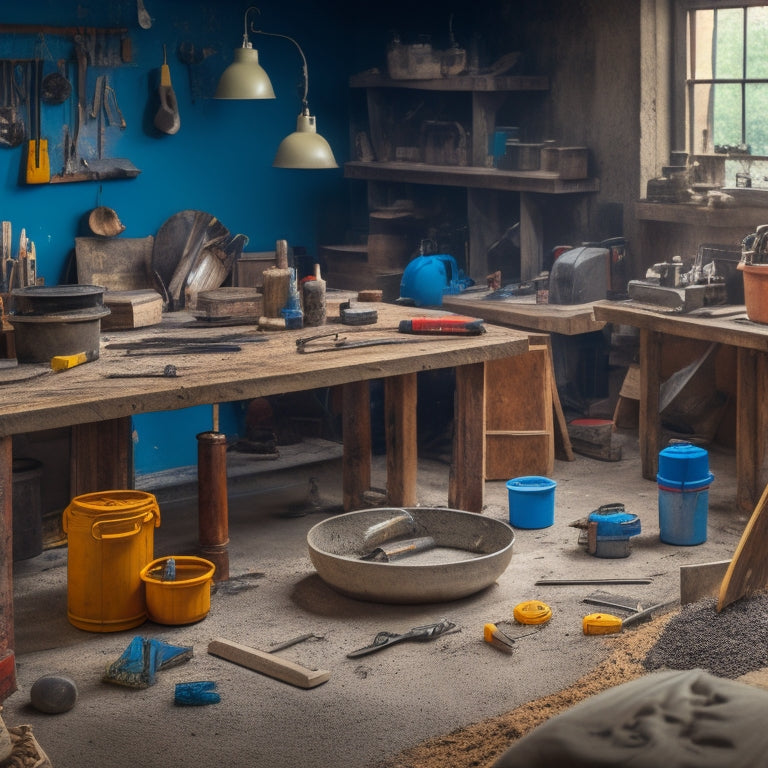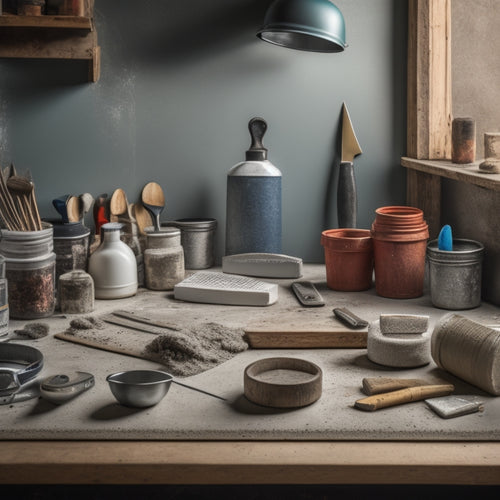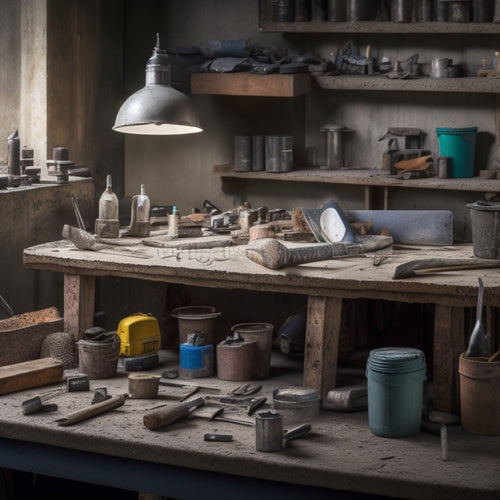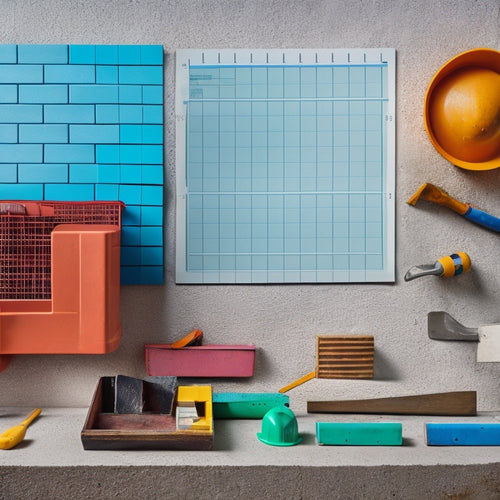
Budget-Friendly Tools for DIY Decorative Concrete Profiling
Share
You can achieve professional-grade decorative concrete results on a budget by investing in the right combination of essential hand tools, affordable power tools, and specialized profiling tools. Start with a trowel, edging tools, and profiling tools for a smooth, even finish. For DIY projects, consider a cordless drill, rotary hammer, or demolition hammer. Polishing and grinding essentials, like sanding techniques, polishing compounds, and diamond abrasives, will help you achieve the desired finish. With these budget-friendly tools, you'll be well on your way to creating stunning decorative concrete projects, and there's even more to discover to take your skills to the next level.
Key Takeaways
• Essential hand tools like trowels, edging tools, and profiling tools are necessary for achieving smooth finishes and crisp lines in decorative concrete work.
• Affordable power tools like cordless drills, rotary hammers, and angle grinders can be used for various DIY decorative concrete projects.
• Polishing and grinding techniques involve selecting the right tools and compounds to achieve desired surface finishes, from matte to high-gloss.
• Stamping and texturing tools like texture mats, stamping tools, and texture skins can create diverse textures and patterns in wet concrete.
• Budget-friendly tools like orbital sanders, impact wrenches, and die grinders can be used to smooth surfaces, remove old concrete, and add textures to create unique decorative effects.
Essential Hand Tools for Profiling
You'll need a set of essential hand tools to effectively profile and shape your decorative concrete, starting with a trusty trowel that can hold its own against rough, freshly poured surfaces. This workhorse will help you achieve a smooth, even finish and is a must-have for any serious DIY decorative concrete enthusiast.
Next, you'll want to add a range of edging tools to your arsenal, including a concrete edger and a margin trowel, which will allow you to create crisp, clean lines and precise curves.
To perfect your profiling techniques, you'll also need a set of profiling tools, such as a float and a finishing trowel, which will help you achieve a high-gloss finish.
Don't forget to prioritize tool maintenance – regular cleaning and storage will guarantee your hand tools remain in top condition and continue to deliver professional-grade results.
Affordable Power Tools for DIY
With your hand tools in place, it's time to boost your productivity and efficiency with affordable power tools designed specifically for DIY decorative concrete projects.
You don't need to break the bank to get high-quality power tools that'll help you achieve professional-looking results. Look for affordable brands like Ryobi, DeWalt, or Makita that offer a range of power tools suitable for DIY decorative concrete projects.
When selecting power tools, consider the type of projects you'll be working on and the frequency of use. For instance, a cordless drill or impact driver is perfect for small to medium-sized projects, while a rotary hammer or demolition hammer is better suited for larger, more demanding tasks.
Remember to prioritize tool maintenance to extend the lifespan of your power tools. Regularly clean and lubricate moving parts, and store them in a dry, secure location.
Proper tool maintenance not only saves you money but also guarantees your safety while working on projects. By investing in affordable power tools and maintaining them properly, you'll be well on your way to achieving stunning decorative concrete profiles without breaking the bank.
Polishing and Grinding Essentials
As you prepare to polish your decorative concrete, you'll need to decide on a polishing method that suits your project's requirements.
You'll find that the right approach depends on the desired level of shine and the type of concrete you're working with.
Polishing Methods Matter
Polishing methods play a crucial role in achieving the desired finish, and selecting the appropriate technique is indispensable to producing a high-quality, visually appealing decorative concrete surface. As you initiate your DIY decorative concrete project, you'll need to reflect on the various polishing methods that will help you achieve the desired surface finish.
When it comes to polishing, you'll want to focus on the following key aspects:
Sanding techniques: Understanding the different sanding techniques, such as wet sanding or dry sanding, will help you determine the best approach for your project.
Surface finishes: Decide on the level of gloss or matte finish you want to achieve, as this will influence your polishing method.
Polishing compounds: Choose the right polishing compounds for your project, taking into account factors like concrete type, surface porosity, and desired finish.
Polishing sequence: Develop a polishing sequence that takes into account the grit progression, polishing direction, and overlapping patterns.
Tool selection: Select the right tools, such as polishing pads or diamond abrasives, to guarantee a smooth and efficient polishing process.
Grinding Surface Preparation
Grinding surface preparation sets the stage for a successful decorative concrete project, requiring you to remove imperfections, old coatings, and contaminants that can impede proper bonding and finishing. As you prepare the surface, you'll need to employ grinding techniques that guarantee a smooth, even finish. This involves selecting the right tools and abrasives for the job.
| Grinding Technique | Abrasive Type | Surface Finish |
|---|---|---|
| Coarse Grinding | 16-20 grit | Rough, textured |
| Fine Grinding | 30-40 grit | Smooth, matte |
| Honing | 60-80 grit | High-luster, reflective |
| Polishing | 100-120 grit | High-gloss, mirror-like |
When choosing your grinding tools, consider the surface finish you're aiming for. Coarse grinding is ideal for removing old coatings, while fine grinding and honing are better suited for achieving a smooth, matte finish. Finally, polishing brings out the highest level of shine and reflectivity. By mastering these grinding techniques, you'll be able to achieve professional-grade surface finishes that elevate your decorative concrete project.
Stamping and Texturing Tools
You'll need to invest in a variety of stamping and texturing tools to achieve the desired patterns and finishes on your decorative concrete projects. These tools will allow you to create unique texture techniques that add depth and visual interest to your concrete surfaces.
When it comes to stamp selection, you'll want to evaluate the type of pattern you're trying to achieve, as well as the size and shape of your concrete surface.
Here are some essential stamping and texturing tools to add to your arsenal:
-
Texture mats: These flexible mats feature raised patterns that can be pressed into wet concrete to create a variety of textures, from subtle to dramatic.
-
Stamping tools: These handheld tools feature interchangeable stamp patterns and can be used to create intricate designs and patterns.
-
Texture skins: These thin, flexible sheets feature raised textures that can be applied to concrete surfaces to create unique finishes.
-
Rock stamps: These tools feature raised patterns that mimic the look of natural stone and can be used to create realistic rock textures.
-
Texture rollers: These rollers feature raised patterns that can be applied to concrete surfaces to create uniform textures and finishes.
Edging and Detailing Solutions
When it comes to edging and detailing your decorative concrete project, you'll need to contemplate the edge profile options that will define the perimeter of your design.
You'll also want to think about the decorative pattern details that will add visual interest and texture to your finished product.
Edge Profile Options
By selecting from a variety of edge profile options, contractors can create visually appealing and functional edging details that enhance the overall aesthetic of their decorative concrete projects. You can choose from a range of profiles to create unique and personalized designs that complement your project's color choices and texture variations.
When it comes to edge profiling, you've got several options to evaluate:
-
Bullnose Edges: A classic choice, bullnose edges feature a smooth, rounded profile that adds a touch of elegance to any project.
-
Beveled Edges: Perfect for creating a sleek, modern look, beveled edges feature a 45-degree angle cut that adds depth and visual interest.
-
Scalloped Edges: Add a touch of whimsy with scalloped edges, which feature a wavy, curved profile that's perfect for creating a playful, decorative look.
-
Chamfered Edges: Ideal for creating a clean, minimalist aesthetic, chamfered edges feature a 45-degree angle cut that adds a touch of sophistication.
-
Radius Edges: Use radius edges to create smooth, curved profiles that add a touch of fluidity to your decorative concrete project.
Decorative Pattern Details
With decorative pattern details, contractors can further enhance their projects by incorporating unique edging and detailing solutions that add an extra layer of visual sophistication.
You can create intricate designs, borders, and patterns using specialized tools and techniques. For instance, you can use a texture mat or a stamp to create texture variations that mimic natural stone, wood, or other materials. Pattern techniques, such as stenciling or engraving, allow you to add intricate designs, logos, or patterns to your concrete surface.
When it comes to edging, you can use a variety of tools to create clean lines, curves, or shapes. An edger or a profiler can be used to create a decorative border around your concrete surface. You can also use a router or a saw to create custom shapes and designs.
By combining different pattern techniques and edging solutions, you can create a unique and visually stunning decorative concrete surface that showcases your mastery of the craft.
With the right tools and techniques, the possibilities for decorative pattern details are endless, allowing you to take your DIY decorative concrete projects to the next level.
Top Picks for Budget Profilers
You'll find that the most cost-effective profiler options for decorative concrete projects lie in handheld power tools, which offer versatility and ease of use without breaking the bank.
These budget-friendly tools are perfect for DIY enthusiasts looking to achieve professional-looking results without investing in expensive machinery.
By mastering the use of these handheld power tools, you'll be able to create intricate designs, patterns, and textures that will elevate your decorative concrete projects.
Here are the top picks for budget profilers:
-
Angle grinders: Ideal for removing old concrete, grinding surfaces, and creating texture.
-
Die grinders: Perfect for detailed work, such as carving and engraving designs.
-
Rotary hammers: Great for breaking up and removing old concrete, as well as creating texture.
-
Orbital sanders: Excellent for smoothing out surfaces and removing imperfections.
-
Impact wrenches: Useful for removing old concrete and preparing surfaces for profiling.
Frequently Asked Questions
Can I Use a Drill Instead of a Dedicated Concrete Mixer?
When considering a drill as a substitute for a dedicated concrete mixer, you'll need to weigh the pros and cons.
While a powerful drill with a mixing paddle attachment can work, it's essential to choose the right drill type and employ proper mixing techniques.
A hammer drill or impact driver might be suitable, but you'll need to guarantee the mixing paddle is designed for concrete and follow a slow, controlled mixing pattern to avoid air pockets and uneven distribution.
How Long Does It Take to Master Decorative Concrete Profiling?
You've finally decided to immerse yourself in decorative concrete profiling, and now you're wondering how long it'll take to master it. Coincidentally, you're not alone - many pros have been in your shoes.
To achieve mastery, focus on skill progression by practicing various decorative techniques regularly. With consistent effort, you'll notice significant improvement within 3-6 months.
However, to truly excel, be prepared to dedicate 1-2 years to honing your craft.
Are Concrete Profiling Tools Suitable for Small-Scale Projects Only?
You might wonder if concrete profiling tools are only suitable for small-scale projects, but the truth is, they're incredibly versatile.
With the right tools, you can tackle projects of various sizes and complexities.
Whether you're working on a small patio or a large commercial space, profiling tools can help you achieve professional-looking results.
Can I Rent Concrete Profiling Tools Instead of Buying Them?
You're likely aware that 75% of contractors consider equipment rental a crucial aspect of their business strategy.
Now, when it comes to concrete profiling tools, you're wondering if renting is a viable option. The answer is yes, you can rent them instead of buying. This approach is particularly beneficial for small-scale projects or infrequent use.
Be sure to explore rental options that include tool maintenance, ensuring you're not burdened with additional upkeep costs. This way, you can focus on perfecting your decorative concrete profiling skills without breaking the bank.
Do I Need a Workshop to Store My Concrete Profiling Tools?
You don't necessarily need a dedicated workshop to store your concrete profiling tools, but you do need a thoughtful approach to tool organization.
Invest in storage solutions like bins, baskets, or a pegboard to keep your tools tidy and accessible. This will save you time and frustration when switching between projects.
Consider a portable storage container or a compact shelving unit to maximize your space, ensuring your tools are always within reach.
Conclusion
You've got the skills, the creativity, and the drive to transform plain concrete into a stunning work of art.
Now, it's time to take the final step: putting your newfound knowledge into action.
As you begin your DIY decorative concrete profiling journey, remember that the right tools can make all the difference.
With these budget-friendly essentials, the only limit to your creations is your imagination.
The concrete canvas awaits - what'll you create?
Related Posts
-

Essential Tools for Concrete Wall Covering Projects
When tackling a concrete wall covering project, you'll need a range of essential tools and equipment. For cleaning an...
-

Top Tools for Concrete Repair Success
When it comes to concrete repair success, you'll need a well-stocked toolkit with essential hand tools like trowels, ...
-

Reinforcement Tools Checklist for Concrete Block Walls
You'll need a range of reinforcement materials, including horizontal and vertical rebar, fiber mesh, and anchor bolts...


